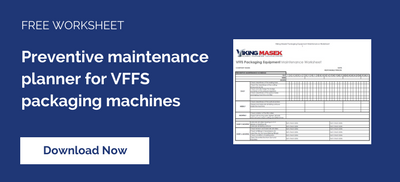[VIDEO] VFFS machine maintenance: How to change a vacuum pull belt on a high-speed packing machine
By Nate Farvour on June 10, 2021
![<span id="hs_cos_wrapper_name" class="hs_cos_wrapper hs_cos_wrapper_meta_field hs_cos_wrapper_type_text" style="" data-hs-cos-general-type="meta_field" data-hs-cos-type="text" >[VIDEO] VFFS machine maintenance: How to change a vacuum pull belt on a high-speed packing machine</span>](https://vikingmasek.com/hubfs/Imported_Blog_Media/Viking_Masek_YouTube_Thumbnail_quick_tip_vacuum_pull_belt.png)
What is a vacuum pull belt?
On a vertical form fill seal (VFFS) machine, pull belts are responsible for gripping the packaging film and transporting it through the packing machine. Pull belts can grip the film for transport in one of two ways:
- Vacuum suction. These belts use a vacuum to suck the film against the belts for transport through the machine. This type of belt is shown in the video above.
- Friction. These belts use friction to grip and pull or push the film. An ideal coefficient of friction must be achieved between the belts/film and film/forming tube for friction belts to work properly.
Generally, vacuum pull belts are considered superior to friction pull belts because they help reduce wear by lowering the pressure needed to pull the film through the VFFS machine. Although more expensive, the expected life of a vacuum belt can span years while the life of friction belts can be mere weeks.
What does a vacuum pull belt do?
The vacuum pull belt transfers air suction from the vacuum manifold to grab onto the film, pulling it through the machine while making the vertical seal. It is critical to have a fully functional pull belt, capable of gripping the film, to maintain peak VFFS machine speed and operating performance.
How to change a vacuum pull belt on a high-speed VFFS machine
CAUTION: Always follow your company's lockout/tagout and PPE procedures when performing machine maintenance. Moving machine parts can cause serious injury to yourself and others. The sealing area may be hot and can cause serious burns.
NOTE: These instructions apply to Viking Masek's Velocity VFFS machine and may not apply to your equipment. Always consult your owner's manual or the manufacturer's service department for instructions related to your specific packing machine.
- Remove the M8 bolt that holds the electrical cabinet to the side of the machine with a 13mm wrench. Once removed, the electrical cabinet can swing open on its hinges, giving you access to the right side of the machine compartment.
- (Optional) Mark the placement of the sliding pulley bolt to achieve the same pully placement when installing the new belt.
- Loosen or remove the nut that holds the top pulley in position with a 24mm wrench.
- With a 13mm wrench, turn the pulley vertical adjustment bolt, located above the top pulley, counterclockwise to lower the pulley and loosen the pull belt. It may be necessary to lightly tap on the bolt to lower the pulley. Once the top pulley is low enough and the belt tension is relieved, remove the belt.
- Install the new belt.
- Turn the pull belt vertical adjustment bolt clockwise with a 13mm wrench to raise the top pulley. This tightens the pull belt. The pull belt should be tightened to the point where it rides firmly on the pulleys and manifold. The belt should not be overtightened or 'banjo string' tight.
- Use a 24mm wrench to install the top pully nut, locking the pulley in position.
- Re-attach the electrical cabinet and install the M8 bolt that holds the cabinet onto the machine before running.
- (Optional) If needed, by loosening the M8 bolts on the front of the vacuum manifold with a 13mm wrench, it is possible to change the manifold's orientation and how it rides on the center of the vacuum pull belt. Sometimes this is necessary to achieve a better vacuum. Keep in mind however that this may also change the gap between the pull belt and the former.
Recommendation: Keep spare pull belts on hand
Many packaging machine owners choose to have a replacement pull belt (or two) ready to rotate in to keep production going and minimize downtime. If you do not have a spare pull belt, contact your packaging equipment manufacturer's spare parts department.
Watch more packing machine maintenance videos
Check out the other videos in our VFFS Maintenance Quick Tips series:
How to change the cutoff knife >>
How to set up automatic film tracking >>
How to set up film registration & train photo-eye sensor >>
Follow a comprehensive spare parts & machine maintenance plan
Machine preventive maintenance and managing your spare parts inventory effectively are two of the most important things you can do to ensure a long, productive life for your packaging line. Download our comprehensive VFFS machine preventive maintenance planner for daily, weekly, monthly, and yearly recommended maintenance tasks:

Related Posts

How to calculate the ROI on a potential packaging machine purchase

Optimizing packaging efficiency: The role of Flow Wrapping Machines in integrated systems
